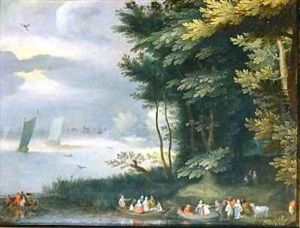Jan Frans van Bredael Paintings
Jan Frans van Bredael or Jan Frans van Bredael the Younger was born in 1686 in Antwerp, a city within the Spanish Netherlands, which is present-day Belgium. He came from a celebrated family of painters that significantly contributed to the Flemish painting tradition, particularly in landscape and battle scenes. His grandfather, Peeter van Bredael, was renowned for market and village scenes, while his father, Joris van Bredael, was noted for his landscapes and architectural paintings. This rich familial background in the arts provided Jan Frans with a fertile ground for developing his painterly skills from a young age.
Van Bredael specialized in painting landscapes, battle scenes, and genre scenes. He was particularly adept at capturing the lush, verdant landscapes of the Flemish countryside, often populated with figures and animals, which he rendered with meticulous attention to detail. His battle scenes, filled with dynamism and a keen sense of drama, were also highly prized for their vivid portrayal of military life and the chaos of warfare. Additionally, van Bredael produced a number of genre paintings that depicted everyday life with a charming and often idyllic quality.
Throughout his career, Jan Frans van Bredael enjoyed considerable success and recognition. He became a master in the Guild of Saint Luke in Antwerp, which was a testament to his skills and his standing among his peers. His works were sought after by collectors and art enthusiasts in the Low Countries and beyond, contributing to the spread of the Flemish painting tradition across Europe.
Despite the acclaim he received during his lifetime, Jan Frans van Bredael's contributions have been somewhat overshadowed by other luminaries of Flemish painting. However, his paintings continue to be appreciated by art historians and collectors for their beauty, technical skill, and historical value. Jan Frans van Bredael passed away in 1750 in Antwerp, leaving behind a legacy that, while not as widely recognized as some of his contemporaries, remains an important part of the Flemish artistic heritage.
